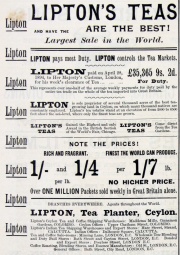Lipton
of City Road, London, EC1. Tea Planters of Ceylon. Telegraphic Address: "Liptonian, Phone, London." Codes: Western Union (5 letter. Western Union. A. B. C. (4th, 5th and 6th Editions)
1871 Thomas Lipton (1848-1931) used his small savings to open his own shop, in Glasgow, Scotland - Lipton's Market.
1888 By this time his empire had grown to 300 stores; Lipton then entered the tea trade and opened his tea-tasting office. He started by-passing traditional trading and wholesale distribution channels (most UK tea-trading was focused in London's Mincing Lane) in order to sell teas at unprecedentedly low prices to the working class. In order to provide his shops with goods, Lipton bought plantations and in doing so - amongst other things - he established the famous Lipton's tea brand.
1890s Thomas Lipton visited Sri Lanka (Ceylon), and made business deals with James Taylor the man who introduced tea plantations to Sri Lanka. Lipton's company purchased good quality tea from Sri Lanka and distributed it throughout Britain in Liptons Stores and Europe and the USA.
1898 Lipton Ltd was registered on 3 March, to take over the provision-supplying business in Great Britain of Sir Thomas J. Lipton, with tea growing estates in Ceylon and factories and warehouses in London and elsewhere. [1]
1914 Tea growers and merchants, provision merchants, naval and military contractors. Specialities: tea, coffee, cocoa, chocolate, preserves (jams, marmalade, bottled fruits etc.), provisions of every description, poultry, game etc. Employees 10,000. [2]
1922 British Industries Fair Advert as the 'Largest Manufacturers and Distributors of Food Products in the World'. Lipton's are the Actual Manufacturers of: Biscuits, Cocoa, Chocolate, Confectionery, Pickles, Sauces, Jams and Jellies, Marmalade, Sausages, Potted Meats, Coffee Essence, Cornflour, Farinaceous Preparations. By appointment to H. M. King of Spain; H. M. King George V; T. M. King and Queen of Italy. (Stand No. B.7) [3]
1930 Allied Stores was registered to acquire Home and Colonial Stores, Meadow Dairy Co, Maypole Dairy Co, Pearks Dairies and the International Tea Company's Stores and also shares of Lipton Ltd[4] but the merger fell through.
1931 Home and Colonial Stores acquired Lipton Ltd[5]
1960 The name of the retail group was changed to Allied Suppliers, with more than 3,000 stores that traded on the high street under a variety of names.[6]
1971 Part of Allied Suppliers when it was acquired by Cavenham Foods
1972 The tea business was acquired by Unilever making its own tea business one of the largest in the world.[7]
Lipton's became a supermarket chain focused on small towns, before Allied's acquisition by Argyll Foods in 1982. The supermarket business was rebranded as Presto during the 1980s.
1982 Part of Argyll Foods. there are 588 convenience stores. [8]
See Also
Sources of Information
- [1] Wikipedia
- ↑ The Stock Exchange Year Book 1908
- ↑ 1914 Whitakers Red Book
- ↑ 1922 British Industries Fair Advert ccxxix; and p49
- ↑ The Times, Jul 12, 1930
- ↑ The Times, Mar 21, 1931
- ↑ The Times May 11, 1960
- ↑ The Times, Aug 24, 1972
- ↑ The Scotsman - Monday 07 June 1982














